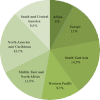Inadequate diabetic care: global figures cry for preventive measures and personalized treatment
- PMID: 23199037
- PMCID: PMC3405299
- DOI: 10.1007/s13167-010-0006-5
Inadequate diabetic care: global figures cry for preventive measures and personalized treatment
Abstract
Diabetes mellitus (DM) is a lifelong progressive disease. Currently there are more than 285 million DM-affected people worldwide. Globally the prevalence of diabetes continues to rise and is more pronounced in countries with large populations such as China, India and USA. Driving forces behind the epidemic are obesity, aging of the population and longer life expency. Prospective, the majority of diabetic population will be in their six to eight decades of life with the implication of more females than males. Severe micro- and macrovascular complications associated with diabetes lead to a highly increased morbidity and mortality. Therefore, DM is projected to be one of the leading health problems of 21st centuary. Urgent measures are required to reduce the diabetic burden. Thus advanced predictive diagnostic tools and personalized treatment strategies in (pre)diabetic care are critical and should exert beneficial impact on public health.
Figures







Similar articles
-
Global burden of diabetes, 1995-2025: prevalence, numerical estimates, and projections.Diabetes Care. 1998 Sep;21(9):1414-31. doi: 10.2337/diacare.21.9.1414. Diabetes Care. 1998. PMID: 9727886
-
[Polish Multicenter Study on Diabetes Epidemiology (PMSDE)--1998-2000].Pol Arch Med Wewn. 2001 Sep;106(3):751-8. Pol Arch Med Wewn. 2001. PMID: 11928582 Polish.
-
The Growing Epidemic of Diabetes Mellitus.Curr Vasc Pharmacol. 2020;18(2):104-109. doi: 10.2174/1570161117666190405165911. Curr Vasc Pharmacol. 2020. PMID: 30961501 Review.
-
The Concept and the Epidemiology of Diabetic Nephropathy Have Changed in Recent Years.J Clin Med. 2015 May 28;4(6):1207-16. doi: 10.3390/jcm4061207. J Clin Med. 2015. PMID: 26239554 Free PMC article. Review.
-
A Compendium of Perspectives on Diabetes: A Challenge for Sustainable Health in the Modern Era.Diabetes Metab Syndr Obes. 2021 Jun 17;14:2775-2787. doi: 10.2147/DMSO.S304751. eCollection 2021. Diabetes Metab Syndr Obes. 2021. PMID: 34168477 Free PMC article. Review.
Cited by
-
Time for new guidelines in advanced diabetes care: Paradigm change from delayed interventional approach to predictive, preventive & personalized medicine.EPMA J. 2010 Mar;1(1):3-12. doi: 10.1007/s13167-010-0014-5. Epub 2010 Mar 16. EPMA J. 2010. PMID: 23199036 Free PMC article.
-
Degenerative valve disease and bioprostheses: risk assessment, predictive diagnosis, personalised treatments.EPMA J. 2011 Mar;2(1):91-105. doi: 10.1007/s13167-011-0072-3. Epub 2011 Apr 3. EPMA J. 2011. PMID: 23199131 Free PMC article.
-
Chromium-picolinate therapy in diabetes care: molecular and subcellular profiling revealed a necessity for individual outcome prediction, personalised treatment algorithms and new guidelines.Infect Disord Drug Targets. 2011 Apr;11(2):188-95. doi: 10.2174/187152611795589717. Infect Disord Drug Targets. 2011. PMID: 21470100 Free PMC article.
-
Opinion controversy to chromium picolinate therapy's safety and efficacy: ignoring 'anecdotes' of case reports or recognising individual risks and new guidelines urgency to introduce innovation by predictive diagnostics?EPMA J. 2012 Oct 7;3(1):11. doi: 10.1186/1878-5085-3-11. EPMA J. 2012. PMID: 23039227 Free PMC article.
-
Ayurpharmacoepidemiology Perspective: Health Literacy (Knowledge and Practice) Among Older Diabetes Patients Visiting Ayurveda Teaching Hospitals in India.J Evid Based Complementary Altern Med. 2017 Apr;22(2):242-250. doi: 10.1177/2156587216643641. Epub 2016 Jul 8. J Evid Based Complementary Altern Med. 2017. PMID: 27074784 Free PMC article.
References
-
- International Diabetes Federation. The Diabetes Atlas (Fourth edition) International Diabetes Federation:Brussels. http://www.diabetesatlas.org/downloads; 2010.
-
- Shaw JE, Sicree RA, Zimmet PZ. Global estimates of the prevalence of diabetes for 2010 and 2030. Diabetes Res Clin Pract (Epub ahead of print). PMID: 19896746; 2009. - PubMed
-
- Centers for Disease Control and Prevention. National diabetes fact sheet: general information and national estimates on diabetes in the United States, Atlanta, GA: U.S. Department of Health and Human Services, Centers for Disease Control and Prevention, 2008. http://www.cdc.gov/diabetes/pubs/pdf/ndfs_2007.pdf; 2007.
LinkOut - more resources
Full Text Sources

